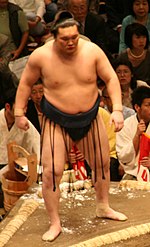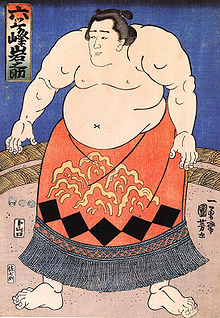Mawashi
This articleneeds additional citations forverification.(May 2012) |
Insumo,amawashi(Hồi し)is theloincloththatrikishi(sumo wrestlers) wear during training or in competition. Upper ranked professional wrestlers wear akeshō-mawashias part of the ring entry ceremony ordohyō-iri.
Mawashi[edit]

For top ranked professionalrikishi,it is made ofsilkand comes in a variety of colours. It is approximately 30 feet (9 m) in length when unwrapped, about 2 ft (0.6 m) wide and weighs about 8 to 11 lb (4 to 5 kg). It is wrapped several times around therikishiand fastened in the back by a large knot. A series of stiffened silk fronds of matching colour calledsagariSagari(Hạ がり)are inserted into the front of themawashi.[1]Their number varies from 13 to 25, and is always an odd number. They mark out the only part of themawashithat it is illegal to grab on to: the vertical part covering thesumotori's groin, and if they fall out during competition thegyōji(referee) will throw them from the ring at the first opportunity.
Sometimes arikishimay wear hismawashiin such a way as to give him some advantage over his opponent. He may wear it loosely to make it more difficult to be thrown, or he may wrap it tightly and splash a little water on it to help prevent his opponent from getting a good grip on it. His choice will depend on the type of techniques he prefers to employ in his bouts. Thus a wrestler preferring belt sumo will usually wear it more loosely, while those preferring pushing techniques will tend to wear themawashimore tightly.

Manyrikishiare superstitious and will change the color of theirmawashito change their luck. Sometimes a poor performance will cause them to change colors for the next tournament, or even during a tournament, in an attempt to change their luck for the better. An example of this was done byŌnoshōduring the 2020 July tournament, when, after several losses in a row, he decided to change from crimson to dark gray.
Rikishionly wear the silkmawashiduring competitive bouts either during ranking tournaments or touring displays. During training, a heavycottonmawashiis worn. For seniorrikishiin the top two divisions (the so-calledsekitori), this belt is coloured white, and it is worn with one end distinctively looped at the front.Sagariare not worn during training.
Rikishiranked in the lower divisions wear a black cottonmawashiboth for training and in competition. In competition, cottonsagariare inserted into the belt, but these are not stiffened.
Amateur sumo wrestlers are expected to wear a white cottonmawashiwithout the looping accorded to the senior professional's training garb.
If a wrestler'smawashicomes off during a tournament bout, he is automatically disqualified.[2][page needed]This is extremely rare, but did occur in May 2000, whensandanmewrestlerAsanokiri'smawashicame off during a match withChiyohakuhō.[3]However, for most of sumo's history, whether or not a wrestler'smawashicame off during a bout was considered irrelevant, and the policy of disqualification only came into place when Japan began adopting European attitudes towards nudity.[3]
Keshō-mawashi[edit]

Wrestlers in the two upper divisions,makuuchiandjūryō,are allowed to wear a second ceremonialkeshō-mawashiduring their ring entering ceremony. The silk 'belt' opens out at one end into a large apron which is usually heavily embroidered and with thick tassels at the bottom. Thekeshō-mawashimay advertise the produce of a sponsor of therikishi(for example BulgarianōzekiKotoōshūwas sponsored by a Japanese brand of yogurt, "Bulgaria", which was prominently displayed on the front of hiskeshō-mawashi) or be a gift from one of therikishi's support groups. Alternatively, some foreign-bornrikishi(such asCzech-bornTakanoyama) bear their national flag on theirkeshō-mawashi.Popularrikishimay be given many of thesekeshō-mawashi.
Yokozunahave matching sets of threekeshō-mawashi,with two being worn by his wrestler "assistants" (histachimochiandtsuyuharai) during his ring entrance ceremony.
In theEdo period,thekeshō-mawashialso served as the wrestler's fightingmawashi.However, as the aprons become more ornate, eventually the two functions were split apart. In this period wrestlers were normally sponsored by feudaldaimyōor overlords, whose clan crest would therefore appear on thekeshō-mawashi.

See also[edit]
References[edit]
- ^"Success for Japan - The Secrets of Sumo".British Chamber of Commerce in Japan. Archived fromthe originalon 28 October 2019.Retrieved28 October2019.
- ^Sharnoff, Lora (1993).Grand Sumo: The Living Sport and Tradition(Revised ed.). New York: Weatherhill.ISBN0-8348-0283-X.OCLC28082775.
- ^abKattoulas, Velisarios (20 May 2000)."Exposed: Sumo Wrestler Who Lost It All".International Herald Tribune.Retrieved2008-05-25.
External links[edit]
 Media related toMawashiat Wikimedia Commons
Media related toMawashiat Wikimedia Commons

